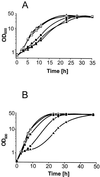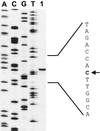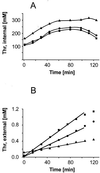L-threonine export: use of peptides to identify a new translocator from Corynebacterium glutamicum
- PMID: 11514515
- PMCID: PMC95414
- DOI: 10.1128/JB.183.18.5317-5324.2001
L-threonine export: use of peptides to identify a new translocator from Corynebacterium glutamicum
Abstract
Bacterial mechanisms for the uptake of peptides and their hydrolysis to amino acids are known in great detail, whereas much less is known about the fates of the peptide-derived amino acids. We show that the addition of L-threonine-containing di- or tripeptides results in reduction of the growth of Corynebacterium glutamicum, with concomitant high intracellular accumulation of L-threonine to up to 130 mM. Using transposon mutagenesis and isolation of mutants with increased Thr peptide sensitivity, nine open reading frames (ORFs) were identified, almost all encoding hypothetical proteins of unknown function. Three ORFs encode membrane proteins. Their individual functional characterizations in the wild-type background led to the identification of thrE. Upon thrE overexpression, growth is no longer sensitive to the presence of the Thr peptide, and L-threonine is exported at a rate of 3.8 nmol min(-1) mg of dry weight(-1), whereas the rate of export of a thrE inactivation mutant is reduced to 1.1 nmol min(-1) mg of dry weight(-1). In addition to L-threonine, L-serine is also a substrate for the exporter. The exporter exhibits nine predicted transmembrane-spanning helices with long charged C and N termini and with an amphipathic helix present within the N terminus. All these data suggest that the carrier encoded by thrE serves to export small molecules such as L-threonine and that the carrier is a prototype of a new translocator family. Homologues of ThrE are present in Mycobacterium tuberculosis and Streptomyces coelicolor.
Figures






Similar articles
-
Export of L-isoleucine from Corynebacterium glutamicum: a two-gene-encoded member of a new translocator family.J Bacteriol. 2002 Jul;184(14):3947-56. doi: 10.1128/JB.184.14.3947-3956.2002. J Bacteriol. 2002. PMID: 12081967 Free PMC article.
-
Identification of glyA (encoding serine hydroxymethyltransferase) and its use together with the exporter ThrE to increase L-threonine accumulation by Corynebacterium glutamicum.Appl Environ Microbiol. 2002 Jul;68(7):3321-7. doi: 10.1128/AEM.68.7.3321-3327.2002. Appl Environ Microbiol. 2002. PMID: 12089010 Free PMC article.
-
A new type of transporter with a new type of cellular function: L-lysine export from Corynebacterium glutamicum.Mol Microbiol. 1996 Dec;22(5):815-26. doi: 10.1046/j.1365-2958.1996.01527.x. Mol Microbiol. 1996. PMID: 8971704
-
New ubiquitous translocators: amino acid export by Corynebacterium glutamicum and Escherichia coli.Arch Microbiol. 2003 Sep;180(3):155-60. doi: 10.1007/s00203-003-0581-0. Epub 2003 Jul 15. Arch Microbiol. 2003. PMID: 12879215 Review.
-
Molecular aspects of lysine, threonine, and isoleucine biosynthesis in Corynebacterium glutamicum.Antonie Van Leeuwenhoek. 1993-1994;64(2):145-63. doi: 10.1007/BF00873024. Antonie Van Leeuwenhoek. 1993. PMID: 8092856 Review.
Cited by
-
Mutations of the Corynebacterium glutamicum NCgl1221 gene, encoding a mechanosensitive channel homolog, induce L-glutamic acid production.Appl Environ Microbiol. 2007 Jul;73(14):4491-8. doi: 10.1128/AEM.02446-06. Epub 2007 May 18. Appl Environ Microbiol. 2007. PMID: 17513583 Free PMC article.
-
A Novel Corynebacterium glutamicum l-Glutamate Exporter.Appl Environ Microbiol. 2018 Mar 1;84(6):e02691-17. doi: 10.1128/AEM.02691-17. Print 2018 Mar 15. Appl Environ Microbiol. 2018. PMID: 29330181 Free PMC article.
-
Characterization of the l-alanine exporter AlaE of Escherichia coli and its potential role in protecting cells from a toxic-level accumulation of l-alanine and its derivatives.Microbiologyopen. 2015 Aug;4(4):632-43. doi: 10.1002/mbo3.269. Epub 2015 Jun 13. Microbiologyopen. 2015. PMID: 26073055 Free PMC article.
-
Export of L-isoleucine from Corynebacterium glutamicum: a two-gene-encoded member of a new translocator family.J Bacteriol. 2002 Jul;184(14):3947-56. doi: 10.1128/JB.184.14.3947-3956.2002. J Bacteriol. 2002. PMID: 12081967 Free PMC article.
-
Environmental regulation operating at the promoter clearance step of bacterial transcription.Genes Dev. 2007 May 15;21(10):1258-72. doi: 10.1101/gad.1520507. Genes Dev. 2007. PMID: 17504942 Free PMC article.
References
-
- Aleshin V V, Zakataeva N P, Livshits V A. A new family of amino-acid-efflux proteins. Trends Biochem Sci. 1999;24:133–135. - PubMed
-
- Bellmann A, Vrljic M, Pátek M, Sahm H, Krämer R, Eggeling L. Regulation and specificity of the LysE-mediated export of amino acids by Corynebacterium glutamicum. Microbiology. 2001;147:1765–1774. - PubMed
-
- Blattner F R, Plunkett G, Bloch C A, Perna N T, Burland V, Riley M, et al. The complete genome sequence of Escherichia coli K-12. Science. 1997;277:1453–1474. - PubMed
Publication types
MeSH terms
Substances
Associated data
- Actions
- Actions
- Actions
LinkOut - more resources
Full Text Sources
Other Literature Sources
Molecular Biology Databases
Miscellaneous

